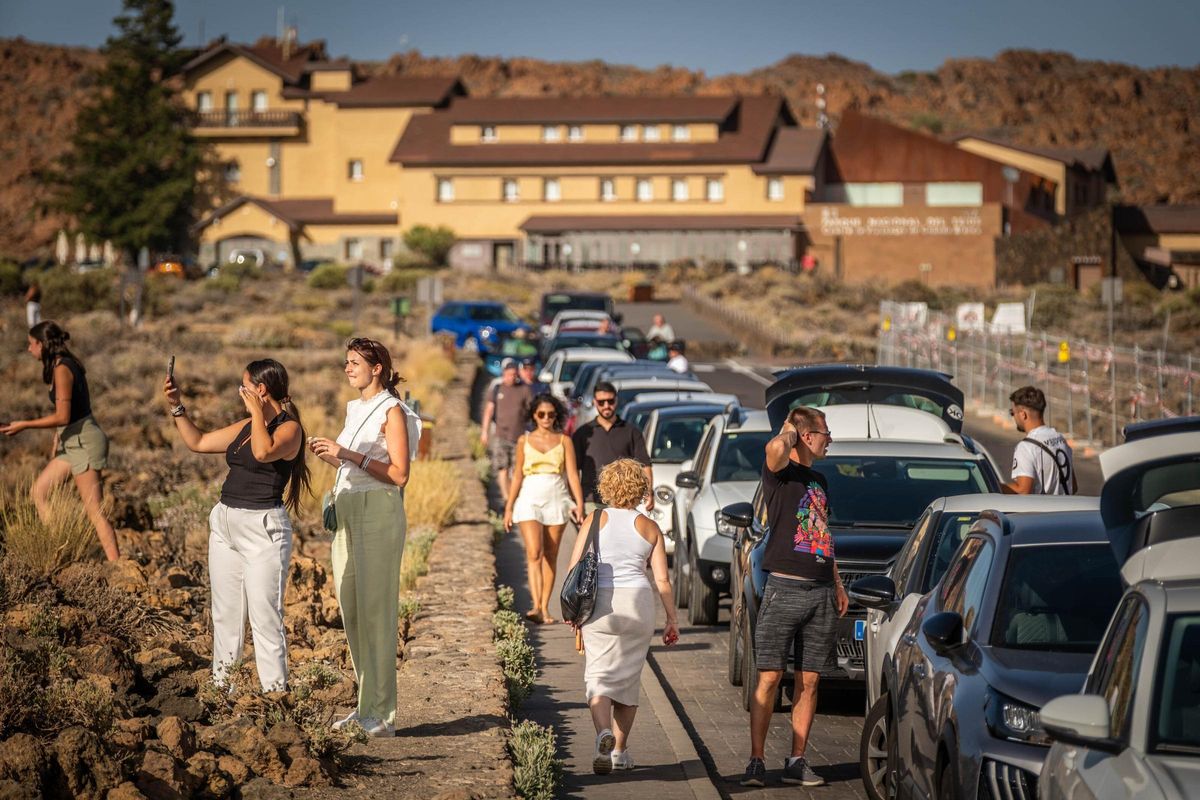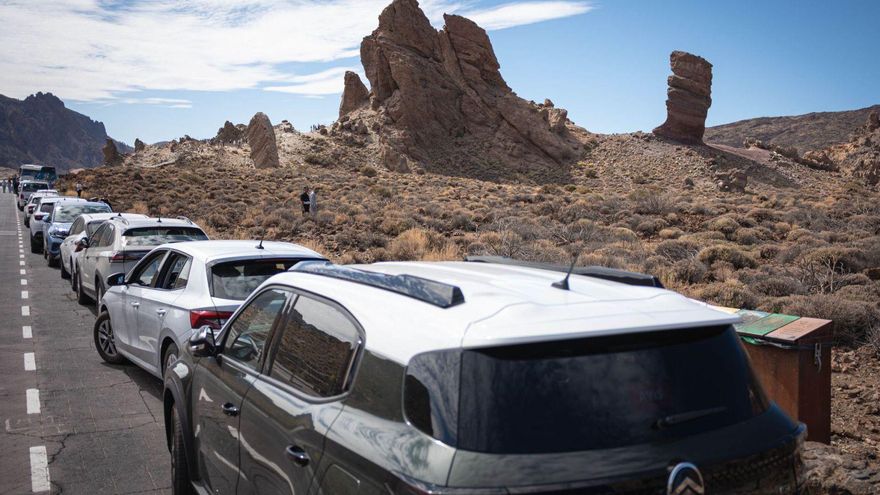- Proposed Restrictions on Private Vehicle Access
- Flexible Approach Suggested by the Presidency Area
- Debate on Sustainable Mobility Plan
- Exceptions for Local Residents
- Consensus on the Development of Interchange Stations
- Visitor Transportation Plans
- Entry Fee and Plans for Funding
- Next Steps in the Discussion
- Expert Opinion on Park Management
New Management Plan for Mount Teide to Address Overcrowding

Tourists enjoying Mount Teide after parking at the Parador de las Cañadas. / Andrés Gutiérrez / t
The new Management Plan for Use and Management (PRUG) of Mount Teide, which the National Park Board will discuss next Monday, aims primarily to combat overcrowding in Europe’s most visited protected area, after it welcomed over five million visitors last year for the first time. This objective has garnered consensus within the Cabildo of Tenerife and the Government of the Canary Islands, which have recently finalised the renewal of the planning instrument for this natural treasure, with the existing document being 23 years old. However, there are differing opinions within the Cabildo regarding how to achieve this goal.
Proposed Restrictions on Private Vehicle Access
The Natural Environment department advocates for a more restrictive model on private vehicles to establish proper and comprehensive protection and to end the current chaos at the summit of Spain due to existing regulations and lack of monitoring resources. This approach involves closing Mount Teide to private vehicles—except in exceptional cases benefiting residents, not tourists—and ensuring visitors primarily access the area via shuttle bus lines operated by the island’s corporation.
Flexible Approach Suggested by the Presidency Area
Meanwhile, the Presidency area, led by José Miguel Ruano, favours a more flexible approach, suggesting that measures should include limitations but not outright bans. Ruano clarifies that there will be time slots during which only buses can operate, alongside other times when private vehicles will be allowed. However, these time distinctions have not convinced the Natural Environment department.
Debate on Sustainable Mobility Plan
In any case, the internal debate is ongoing regarding the best approach to enhancing the protection of the Teide National Park, whose biodiversity is extremely sensitive to any disturbance. The newly agreed Management Plan for Use and Management, established between the island corporation and the regional government after a year of negotiations, places the responsibility for drafting a sustainable mobility plan in the hands of the former administration.
Exceptions for Local Residents
The stricter proposal includes exceptions for the passage of cars and motorbikes along the TF-21 that would benefit residents of Tenerife. Permits would be granted to those working in the National Park, those with authorised beekeeping operations, mountaineers, scientists, guests of the Parador, and emergency and safety teams.
Additional specific permits for residents could also be arranged, depending on the number of people present inside the area at any given time. If the number of visitors exceeds the capacity that Mount Teide can accommodate, then those permits would not be granted. The Natural Environment department believes that the roads built with the Insular Ring allow for restrictions on the TF-21 since it is no longer used as a main transit route from the north to the south of the island.
Consensus on the Development of Interchange Stations
There is consensus among the Cabildo and between this administration and the Government of the Canary Islands to reject the proposal from former councillor José Antonio Valbuena to build three interchange stations for shuttle buses in El Portillo, Vilaflor, and Chío, located on the edges of the National Park, for visitors to park their vehicles.
Visitor Transportation Plans
The plan is for visitors to use the buses provided by the Cabildo from existing interchange stations in the Metropolitan, North, and South areas and to utilise circular lines that will constantly traverse the entirety of the area once within Teide. The construction of interchanges is not entirely ruled out, but locations would be further away from Teide, as even being outside the limits of the site could still create environmental impact.
Entry Fee and Plans for Funding
The payment of an entry fee to Mount Teide has been dismissed due to national legislation. However, the Cabildo plans to charge for services, particularly for the buses that will transport visitors to the National Park and around its interior. This would be free for Tenerife residents — akin to the rest of the public transport on the island — but not for tourists. Part of the revenue would be allocated to cover transportation costs, while another portion would be dedicated to conservation projects.
Next Steps in the Discussion
The new Management Plan will be debated next Monday by the National Park Board of Mount Teide, an advisory body chaired by the president of the Cabildo, Rosa Dávila, with representation from the Government of Spain, the Government of the Canary Islands, the Cabildo of Tenerife, six municipalities, the University of La Laguna (ULL), scientific institutions, security bodies, and business and social collectives. The expectation is that the state government will provide final approval in December.
Expert Opinion on Park Management
Professor of Botany at ULL Wolfredo Wildpret, an honorary member of the Board and at 92 years old, knows Mount Teide as well as anyone. He firmly believes that it “cannot remain so overcrowded” and has stated that drastic restrictions are necessary to prevent irreparable degradation of this UNESCO World Heritage site.














